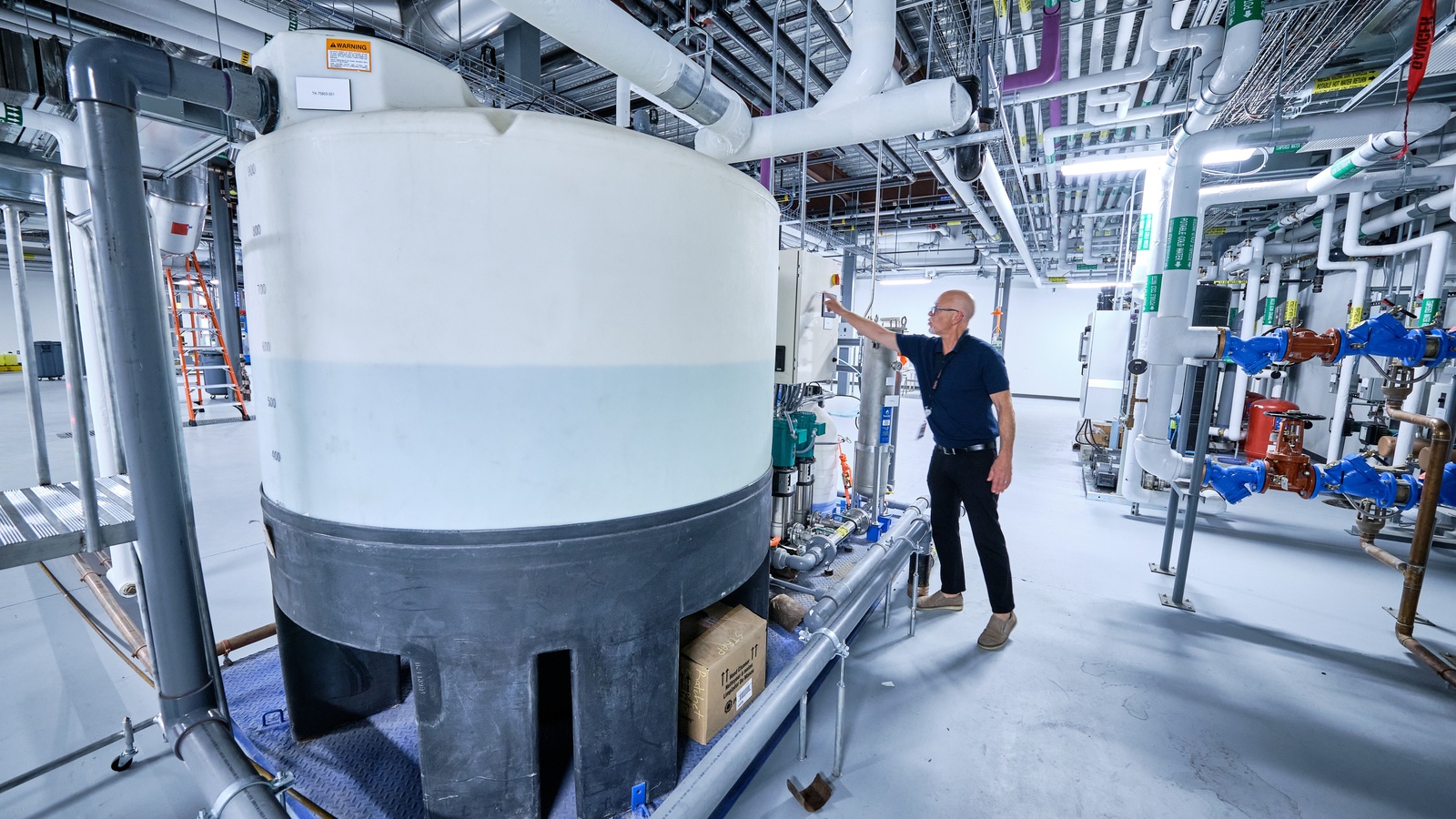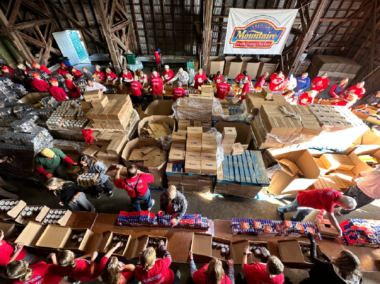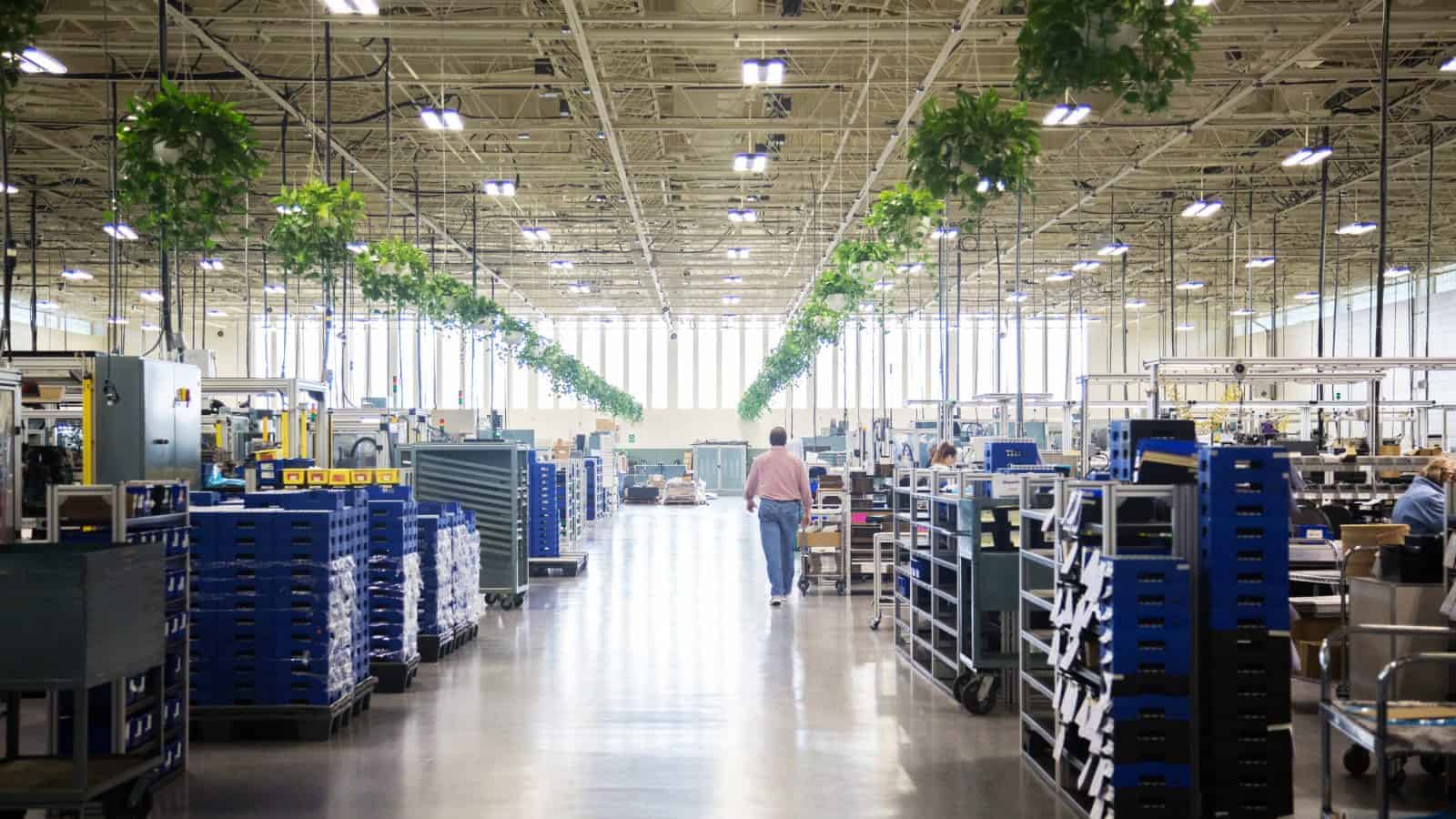Environmental Firm Langan Takes on ‘Forever Chemicals’

The race to remove PFAS from its remaining industry uses is on—and according to Langan’s Stewart Abrams, must be “a sprint, not a jog.”
In high demand: Abrams is a principal and director of remediation technology at Langan, a national environmental and engineering firm. He leads the consulting firm’s remediation practice, specializing in the treatment of perfluoroalkyl and polyfluoroalkyl substances, chemical compounds that were used widely in household products—including fire extinguishers—for decades.
- It’s an area of expertise that will soon be highly sought after, given the Environmental Protection Agency’s proposal earlier this year of drinking water maximum contaminant levels (MCL) of 4 parts per trillion (ppt) for both PFOA and PFOS. This will not only affect drinking water but will become an important standard for remediation sites as well.
- Langan has clients—including property owners and developers—who focus on the removal of PFAS from contaminated groundwater.
“What’s possible”: “Part of what Langan is doing is focusing on what is possible” regarding PFAS removal, Abrams said.
- “We’re looking at the treatment of groundwater and drinking water. We’re also working on how to deliver existing and new technologies to site cleanup. We’re going to have to move faster than ever before to bring these technologies to the marketplace. It’s a sprint, not a jog.”
Land remediation: Langan has long worked with property developers, helping them clear land of contaminants before building begins. PFAS issues, however, have changed the game considerably.
- “Now we’re looking at projects [for clients] where the question is, ‘How do you use water or land that’s been PFAS-contaminated?’” Abrams said.
- “Some companies have legacy contamination at the sites” they want to build on, and solutions aren’t always forthcoming, he continued.
Airports and PFAS: Another significant Langan customer sector? The aviation industry. Since 2022, airlines operating at California airports may no longer use PFAS in firefighting foam, a common use of the compounds for many years owing to their fire-extinguishing capabilities.
- “They’ve had to adopt new methods of firefighting at [California] airports,” said Abrams of Langan’s aviation clients in that state. “It’s hard because you need a lot of this fluid to address a fire given the amount of fuel on an airplane. The problem is that often the large water reservoirs at these airports have until recently contained a lot of PFAS.”
- That contamination isn’t limited to the water, Abrams added, but extends to everything the PFAS has touched. “Everything in the [firefighting] systems—the pumps, the nozzles, the piping—are contaminated, as is the storage reservoir itself. Part of the complexity of removal is cleaning all of it and then finding an alternative” surfactant, a chemical compound that can effectively extinguish fire.
- In addition, the sponge-like concrete that often lines the reservoirs at airports may have absorbed the chemical, requiring removal and replacement.
Finding solutions: About a decade ago, Langan and the New Jersey Institute of Technology began an informal research partnership.
- Members of Langan’s staff have access to NJIT’s environmental engineering laboratories, where they can set up experiments to solve client challenges. Now the company is leveraging that relationship to find solutions to PFAS problems.
- The labs are “a great [place] to bring in new ways of doing things with PFAS,” Abrams told us. “We’re exploring new treatment methods, new characterization methods, and we will be working to accelerate those technologies to market.”
Taking practical action: The strong carbon-fluorine bonds in PFAS chemicals render them harder to destroy than other contaminants, Abrams noted.
- “Unlike with other compounds—particularly volatile organic compounds and chlorinated solvents—with PFAS, we can’t quite track down all of it,” he continued. “It’s out there in the environment; it would be extremely difficult to chase down every molecule. Instead, we want to bring a theme of pragmatism to PFAS cleanup.”
Michigan Homebuilders Push Back on Air Quality Proposal

“Policy can’t be developed in a vacuum,” says Dawn Crandall, executive vice president of government relations for the Home Builders Association of Michigan. “People need to look at how one policy impacts that next thing. Everything is tied together.”
That’s Crandall’s message for the Environmental Protection Agency, as it considers a proposed air quality rule to restrict particles called PM2.5. While the regulations might not appear to impact the housing industry directly, they could prevent manufacturers from expanding facilities and creating jobs in Michigan—which does affect the housing market.
The concern: If manufacturers are unable to grow in the state or open new facilities, fewer people will need housing. That’s bad news for homebuilders.
- “If you put in these EPA regulations that are going to create a barrier for companies looking to move here, and then they decide they don’t want to, that’s going to impact Michigan’s ability to be an economic destination,” said Crandall.
- “And if you make it harder for businesses to employ employees, then they don’t need housing. That has a big impact on us.”
A shaky foundation: Michigan’s housing industry is still recovering from the significant downturn it experienced about 15 years ago.
- That slump was dramatic: according to Crandall, the number of permits filed in Michigan for single-family homes fell sharply from 54,721 in 2005 to around 15,000 two years later, bottoming out to about 6,900 in 2009.
- Although the industry has seen some recovery since then, new construction remains relatively low, and Crandall worries that shocks caused by the EPA’s proposed regulations could do further harm.
- “I think we’ve hit rock bottom, and we’re slowly coming out of it,” said Crandall. “But we’re only projecting 16,000 single-family permit builds this year—and anything that’s going to impact residential construction is not good for the state of Michigan.”
Another challenge: Ultimately, Crandall is concerned that the EPA’s proposed rule will simply add to a long list of challenges for homebuilders.
- “We’re already facing enough hurdles,” said Crandall. “There’s a lack of skilled workers who can do residential construction. Material costs peaked during COVID. We get a lot of our lumber from Canada, so these Canadian wildfires could have an impact. So if PM2.5 is going to affect economic development in our state, that’s going to have an impact on us, too.”
The big idea: “We’re all connected in some form or fashion,” said Crandall. “Michigan needs to grow our population, and we can’t do that if companies don’t bring people into our state who want to live, work and play here. We’re one big ecosystem.”
Illinois Chemical Industry Warns Against New EPA Standard

The chemical industry has a wide reach. According to Mark Biel, CEO of the Chemical Industry Council of Illinois, 96% of products made in the United States are either manufactured by the chemical industry itself or using materials it produces.
- “We make everything from cell phones to packaging,” said Biel. “People don’t realize the integral role that chemistry plays in their lives.”
And for Illinois in particular, the chemical industry isn’t just making products—it’s making careers.
- “Our state has 46,000 people in the chemical industry, and the average wage is a little over $114,000,” said Biel. “We are the second largest manufacturing sector in Illinois, which is the fourth largest chemical processing state. Folks don’t realize how large and important the chemical industry is to Illinois.”
But as the Environmental Protection Agency considers imposing a new, stricter air quality standard for particles called PM2.5, chemical manufacturers in Illinois are sounding the alarm. According to Biel, the new regulations misunderstand the situation—and threaten to cause irreparable harm for manufacturers across the state.
The background: Manufacturers have long been committed to reducing particulates in the air, including PM2.5, and have made huge strides over the past half-century. But to further reduce PM2.5 will be a tall order.
- “We should be focused on enforcing the regulations we already have in the books,” said Biel. “The U.S. already has strong regulations in place—ones that many areas are still working to meet. Let us be smart about new regulations, which means we should not change air permitting before meeting current standards.”
The local angle: For the chemical industry in Illinois, the changes could be particularly damaging.
- With access to waterways, relatively inexpensive electricity and extensive natural gas pipeline infrastructure, the St. Louis and Chicagoland areas of Illinois are hubs for the national chemical industry.
- However, if the EPA’s standards become stricter, it could deter investments to these metro areas significantly.
- “It’s difficult enough to permit a new facility in the Chicagoland area, and when you throw on additional burdens, it makes it harder and harder to justify making the investment in these facilities,” said Biel.
The global stage: Especially at a time when many manufacturers are looking for ways to bring investments and supply chains back to the United States, this kind of onerous regulation could create a stumbling block.
- “Our lawmakers want manufacturing to come back to the U.S., but this regulation does the exact opposite,” said Biel. “With all the new investment, it’s important that more and more manufacturers locate in the U.S. to avoid supply chain complications and delays. This regulation hinders that development.”
The last word: “I’m bullish on the long-term prospects for our industry, but sometimes the EPA loses sight of the reality that their regulations are already sufficient,” said Biel. “The current PM2.5 standard has worked. But this proposal goes far beyond that and will hinder a crucial opportunity for the industry to grow in the U.S.”
Manufacturers: Lowering Particulate Matter Standard Would Harm Infrastructure Investment
Washington, D.C. – Following a request from White House Environmental Justice Advisory Council Chair Brenda Mallory asking the Environmental Protection Agency to lower the annual primary standard for particulate matter (PM2.5) to 8.0 μg/m3 and to lower the primary 24-hour standard to 25.0 μg/m3, National Association of Manufacturers Vice President of Domestic Economic Policy Brandon Farris released the following statement:
“Moving the PM2.5 standard all the way down to 8.0 μg/m3 as the White House Environmental Justice Advisory Council suggested means 40% of the U.S. population will live in an area considered ‘out of attainment,’ essentially halting construction on bridges, roads, manufacturing facilities and agriculture projects in areas that desperately need development.
“Manufacturing in the U.S. is already among the cleanest in the world, and we don’t have to make a choice between cleaner air and economic prosperity. The EPA can choose both by finalizing a reasonable standard that doesn’t thrust much of the country into an area where no growth can happen.
Background: A new report conducted by Oxford Economics and commissioned by the NAM warns that the EPA’s proposed air quality regulations for PM2.5 could threaten $162.4 billion to $197.4 billion of economic activity and put 852,100 to 973,900 jobs at risk, both directly from manufacturing and indirectly from supply chain spending. In addition, growth in restricted areas may be constrained, limiting investment and expansion over the coming years. Due to these limited opportunities for expansion or investment, these areas in nonattainment could lose out on an additional $138.4 billion in output and 501,000 jobs through 2027.
-NAM-
The National Association of Manufacturers is the largest manufacturing association in the United States, representing small and large manufacturers in every industrial sector and in all 50 states. Manufacturing employs nearly 13 million men and women, contributes $2.91 trillion to the U.S. economy annually and accounts for 55% of private-sector research and development. The NAM is the powerful voice of the manufacturing community and the leading advocate for a policy agenda that helps manufacturers compete in the global economy and create jobs across the United States. For more information about the NAM or to follow us on Twitter and Facebook, please visit www.nam.org.
Committing to Net-Zero Emissions: Thermo Fisher Takes Action

Thermo Fisher Scientific of Waltham, Massachusetts, has made a big commitment to the environment, as well as to its customers and partners: to achieve net-zero emissions across its entire value chain by 2050.
By 2026, thanks to virtual power purchase agreements, all of the company’s current U.S. sites will be running on 100% renewable electricity.
And that’s not all. Last December, Thermo Fisher, a global life sciences leader, announced its intention to slash Scope 1 and 2 emissions—those generated directly by the company and by energy the company has purchased, respectively—by more than 50% by 2030 (from a 2018 baseline). At the end of 2022, the company had already cut emissions by 25%, putting it ahead of schedule.
Environmental sustainability: Thermo Fisher signed on to the Business Ambition for 1.5˚C campaign, which urges companies to reduce emissions sufficiently to cap the global temperature increase at 1.5 degrees Celsius. The campaign is led by the Science Based Targets initiative—the leading global standard setter for private companies’ climate goals—in partnership with the United Nations Global Compact and the We Mean Business Coalition.
- To reach that goal, global emissions must be halved before 2030, and the world must get to net-zero emissions before 2050, according to the SBTi.
- It’s a significant effort, but one Thermo Fisher—which is among the first companies in its industry to have its near- and long-term net-zero goals validated by the SBTi—is glad to take on.
- “Our commitment to the environment is deeply rooted in our mission to enable our customers to make the world healthier, cleaner and safer,” said Meron Mathias, vice president of Corporate Social Responsibility & Sustainability for Thermo Fisher Scientific. “By championing a healthy planet that sustains human health and natural resources, we can build a brighter future for generations to come.”
Making progress: While transitioning completely away from fossil fuels for its operations would require “clean energy technologies that aren’t yet available,” Mathias said the company has made significant recent strides in decreasing its carbon footprint. In 2022 alone, Thermo Fisher:
- Transitioned 20 of its facilities across the globe to operate without the use of fossil fuels (defined as at least 99% of total energy consumed from renewable sources).
- Powered 150 of its sites worldwide solely with renewables.
- Saw 13% of its suppliers (by spend, an industry metric) set a science-based target and another 10% commit to set a science-based target.
Key drivers of this progress include:
- Signing contracts to add 900,000 megawatt hours of renewable electricity to the electrical grid through power purchasing agreements (roughly the amount of electricity needed to power 82,000 average modern homes for a year).
- Purchasing enough wind and solar electricity to fuel all current U.S. sites by 2026, via virtual power purchasing agreements.
- Setting a Scope 3 emissions target to have 90% of its suppliers by spend set science-based targets by 2027.
All hands on deck: Thermo Fisher is also accelerating progress toward its sustainability goals in large part thanks to the company’s Practical Process Improvement Business System, according to Mathias.
- “A lot of our early wins in environmental sustainability have been through PPI,” she said. “For example, somebody seeing waste in the system, or identifying an opportunity to tweak something to make it better for the environment and customers. Our teams are empowered to find a better way every day—for our customers, our business and our planet.”
West Virginians Push Back on Stricter EPA Air Standards

Jason Asbury wants to clear up a misunderstanding.
The vice president for geotechnical and field services at TERRADON Corporation—the largest woman-owned engineering business in West Virginia—knows that West Virginia’s leadership in the energy industry has created a negative stereotype about West Virginians and environmentalism. But he also knows that the reality is very different.
- “There’s a misconception that we don’t care about the environment, and that couldn’t be further from the truth,” said Asbury. “We’re some of the most outdoorsy people you’ll ever meet, and we care about nature, about the mountains, the waterways, the clean air—that’s why we live here. This is home for us, and we feel a duty to make sure that everything we do protects the environment.”
But as the Environmental Protection Agency considers a more restrictive standard for clean air, Asbury is also warning that the rule is unrealistic and ultimately harmful, and that it will cause painful repercussions in West Virginia and beyond.
A strict standard: The EPA rule under consideration, which would govern particles known as PM2.5, would impose additional tight regulations on manufacturers and others across the country. According to Asbury, those regulations would harm businesses without resulting in real benefits.
- “It’s potentially overkill,” said Asbury. “Everybody in sectors from engineering to construction and manufacturing is doing all they can to ensure we have clean air—but we’re trying to balance having clean air with being profitable and having jobs and economic growth in our communities. Groups like ours are already working toward environmental goals, and this rule hinders that.”
A heavy burden: The EPA’s proposed rule would impose significant costs and delays for companies, Asbury continued.
- “It’s more burdensome on the permitting and regulatory side to attempt to meet a standard that may or may not be attainable,” said Asbury. “That causes design overruns and more costly projects.”
- “It causes us to miss deadlines and push projects back. If projects get canceled, we’re laying off staff. And if folks don’t want to go through this extra layer of regulation, then there’s a potential for bigger job losses in the community.”
A message to policymakers: Asbury wants policymakers to understand that these rules aren’t just about numbers on a spreadsheet; they have real human consequences.
- “Have you ever tried to do what you’re asking others to do?” said Asbury. “Have you ever tried to run a project under these regulations? Have you ever had to tell people that they don’t have a job due to a project being killed because of regulations like this one? It’s easy to make these rules when you’re not responsible for signing the front of a check.”
California Agriculture Workers Warn Against EPA Proposal

Manufacturers have long been leaders in sustainability, as have their partners in the agricultural industry. But as the Environmental Protection Agency considers imposing new restrictive air standards, groups across the country are speaking out in opposition.
In California, a group called the Nisei Farmers League is making noise.
Formed by a small group of Japanese American growers in 1971 as a “mutual protection society,” the NFL has become a well-respected organization committed to serving the needs of growers, farm workers and other members of the agriculture community in California. Today, they are sounding the alarm about a proposed EPA rule that would enforce a tighter national ambient air quality standard for fine particle pollution known as PM2.5—a move that could impact everything from permitting to international competition.
Widespread impacts: According to NFL President Manuel Cunha Jr., the regulations could be devastating for growers in California and farmers across the country.
- “There are issues with this regulation that the public just doesn’t realize,” said Cunha. “It impacts jobs. It impacts our ability to move freight. If you think the cost of food is high today, it will be even higher if this rule goes into effect.”
A closer look: Cunha knows the impacts of regulations like this one firsthand. He tells the story of a colleague who uses machinery to dehydrate fruits like apricots and peaches, but whose machinery would be unaffordable if he was forced to adhere to the stricter standard.
- “If they come out with a new standard, he’ll have to shut down,” said Cunha. “He can’t afford to build new equipment—the cost is unsustainable. It’s not economically feasible. And that’s what they’re telling our farmers to do.”
Impeding growth: Rapid shifts in environmental standards have also made it difficult for growers and other members of the agricultural community to adjust and succeed.
- “These standards keep changing, and it’s impossible to keep up,” said Cunha. “Our area in the San Joaquin Valley has seven plans with the EPA that are waiting for approval, and every time we turn around, there is another standard holding us back.”
- Meanwhile, strict standards imposed on other parts of the supply chain create costs that get passed along to farmers.
A message to policymakers: Cunha is speaking out because he wants policymakers to think about the realities of the proposed rule—including the costs that states will bear and the ripple effects throughout the agricultural supply chain.
- “How do we keep jobs?” said Cunha. “How do we keep our rural communities alive if you’re developing rules that don’t have the facts and the science behind them? Politicians are going on the basis of what looks and sounds good, but you have to realize that what you’re doing is driving out small farmers.”
“Mountaire Cares” Is More Than Just a Slogan
“Making a difference” might be the best description of what Mountaire Farms does. Founded in 1914, the fifth-generation family-owned chicken processing company has a long history of helping its communities thrive.
Mountaire Cares: Through its Mountaire Cares program, the company’s employees are committed to changing lives for the better.
- “The Mountaire Cares program was created to fulfill three main core pillars: how are we faithful to our people, how are we faithful to our communities and how can we look to be faithful to the future,” said Mountaire Cares Director JR LaPearl.
Meals for thousands: One of Mountaire Farms’ biggest events during the year is its Meals for Thousands program, where the company partners with local churches, food banks and nonprofit organizations to provide meals for families in need at Easter, Thanksgiving and Christmas.
- The program had humble beginnings 28 years ago, with Roger Marino, who was PR and community relations director at Mountaire, leading the group to provide 300 meal boxes at Thanksgiving. The company has distributed more than 1 million boxes since then.
- For this year’s Easter event, the company’s employees and other volunteers packed 15,000 meal boxes, each of which contained a Mountaire roaster chicken; vegetables; macaroni and cheese; mashed potatoes and gravy; and brownies—enough food to feed a family of four.
- “Our employees really enjoy being a part of this effort to give back to the community,” LaPearl said. “What I love about these events is that they bring people together to share love and kindness to one another.”
Feeding all year long: But hunger doesn’t just exist during holidays. Mountaire Farms donates chicken to local food pantries every month so they can help fill the need all year long. And they partner with groups like nonprofit organizations, little leagues, fire companies and more that use chicken to help fundraise during the year.
And that’s not all . . . Mountaire’s food programs are just one way the company gives back. It has partnered with Habitat for Humanity and several Boys & Girls Clubs on service projects, while also collaborating with local schools on renovations of playgrounds and basketball courts.
Why they do it: For LaPearl, it all starts with the company’s mantra “High Performance for a Higher Purpose,” striving to be a positive light to those around them.
- “Our people are the reason we’re able to do what we do and give back,” said LaPearl. “If it’s not volunteering, it’s the everyday work that we do that really helps to feed families here locally, around the region and around the world. It’s interesting when our employees are upset they were unable to volunteer on a particular day. I remind them that what you’re doing on a daily basis is making a major impact in the lives of people that you don’t even know because of your hard work and performance.”
- “When I have the opportunity to visit our processing plants and I see people smiling, singing in their respective cultural languages and just enjoying their job, that speaks volumes in today’s culture. I can tell they love being here. That’s the way we’re built.”
Mountaire cares about its employees: Through Mountaire Cares, the company offers leadership classes to help employees succeed in their roles and advance in their careers. It also provides scholarships to children and grandchildren of employees.
- In addition, the company built medical facilities at each of its processing plants, and recently established a chaplaincy program that offers employees guidance in times of crisis and high stress.
The last word: LaPearl has some advice for manufacturers who may want to start a program similar to Mountaire’s:
- “Clearly understand your strengths as a company and create an exceptional foundation to build off that. We weren’t able to do all of this overnight, so start small and really focus the first few years on going slow and being purposeful. And always show your employees you care.”
“Mountaire Cares” Is More Than Just a Slogan

“Making a difference” might be the best description of what Mountaire Farms does. Founded in 1914, the fifth-generation family-owned chicken processing company has a long history of helping its communities thrive.
Mountaire Cares: Through its Mountaire Cares program, the company’s employees are committed to changing lives for the better.
- “The Mountaire Cares program was created to fulfill three main core pillars: how are we faithful to our people, how are we faithful to our communities and how can we look to be faithful to the future,” said Mountaire Cares Director JR LaPearl.
Meals for thousands: One of Mountaire Farms’ biggest events during the year is its Meals for Thousands program, where the company partners with local churches, food banks and nonprofit organizations to provide meals for families in need at Easter, Thanksgiving and Christmas.
The program had humble beginnings 28 years ago, with Roger Marino, who was PR and community relations director at Mountaire, leading the group to provide 300 meal boxes at Thanksgiving. The company has distributed more than 1 million boxes since then.
- For this year’s Easter event, the company’s employees and other volunteers packed 15,000 meal boxes, each of which contained a Mountaire roaster chicken; vegetables; macaroni and cheese; mashed potatoes and gravy; and brownies—enough food to feed a family of four
- “Our employees really enjoy being a part of this effort to give back to the community,” LaPearl said. “What I love about these events is that they bring people together to share love and kindness to one another.”
Read the full story here.
Voluntary Climate Disclosures Show That SEC Rule Is Redundant

An aggressive climate-disclosure rule proposed by the Securities and Exchange Commission hasn’t yet become law, but many companies are already adopting climate-disclosure practices and methodologies, according to The Wall Street Journal (subscription).
- Companies’ efforts to adopt climate strategies appropriate for their businesses, as well as the evolving methodologies for such reporting, are clear indications that the SEC’s costly and overly restrictive climate-reporting mandate is not necessary, said NAM Senior Director of Tax and Domestic Economic Policy Charles Crain.
What’s going on: “The Securities and Exchange Commission’s rule—which would require public companies to report climate-related risks and emissions data, including so-called Scope 3 emissions that come from a company’s supply chain—is expected to be brought in soon. … [But] [s]ome businesses have for years pursued carbon-related goals without the government forcing their hand,” according to the Journal.
- Manufacturers have led the move toward sustainability, with many having already begun to track and curb their emissions and work with their suppliers to do the same.
Why it’s important: “[G]roups from private manufacturers to egg farmers have balked at the cost and complexity of complying with a Scope 3 mandate from the SEC. The regulator has estimated its plan will raise the cost to businesses of complying with its overall disclosure rules to $10.2 billion from $3.9 billion, an additional cost of about $530,000 a year for a bigger business.”
- Manufacturers have urged the SEC to drop the Scope 3 reporting mandate. Some say it unfairly “creates a risk of double counting, because the supply-chain emissions of one company are the in-house emissions of another,” according to the Journal.
- While SEC Chair Gary Gensler told the House Committee on Financial Services earlier this month that the rule is not intended to burden private companies, “[m]andatory Scope 3 reporting would represent a costly, uncertain and ultimately infeasible standard for public issuers as well as the small and privately held businesses within their supply chains,” NAM Managing Vice President of Tax and Domestic Economic Policy Chris Netram told the same committee.
The last word: “Manufacturers [are] leaders in combatting climate change and making the necessary disclosures about this important work,” said Crain.
- “The SEC’s attempt to mandate a top-down, uniform approach to this evolving field would dramatically increase costs and legal liability for manufacturers—without improving information availability for investors or helping companies achieve their sustainability goals.”
